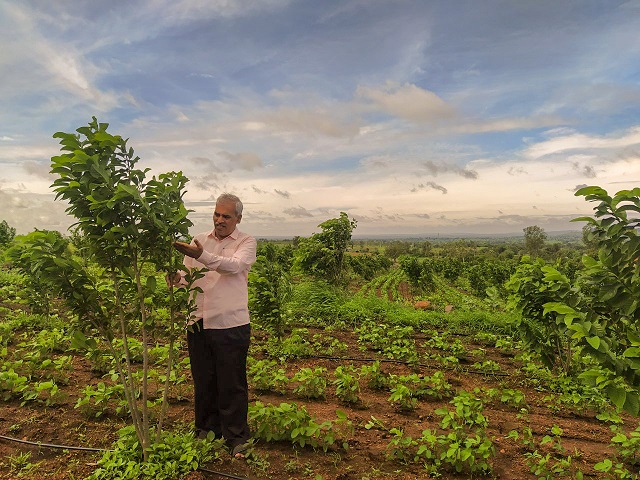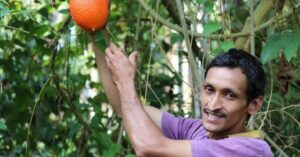50-YO Professor Takes Out Rs 25 Lakh Loan, Digs a Well For Ancestral Village
“I feel blessed that I have been worthy of my village. My savings have been wiped out, but I am confident that once my crops begin fruiting, I will be able to clear off my debts,” says Prof Kamate.

A human-made lake has recharged wells and ushered in prosperity in the semi-arid villages of Hattarawat and Manganur in Karnataka’s Belgavi. It was created to serve as a watering hole for wildlife as well as domesticated animals.
“It is nothing less than a miracle,” says Lagamanna Gouroji, 50, who owns five acres in Manganur village.
He continues, “In the past, we could hardly have a crop during the two months of rain. Now, we have two crops. I grow chilli, bajra and sunflowers.”
Moving around the hamlets here, you’re likely to hear similar stories from other families. These include Kulkarnis, Lolasures, Mastihallis, Nimmedars, Haragapures, Gourojis, Hirekudis and others.
A vast stretch of an undulating barren patch of land without a single blade of grass, but for the boulders scattered here and there. This is what Hattarawat and its neighbouring village, Manganur, in Chikodi taluka of Belgavi had been.
With the land unable to provide them with sustenance, villagers sought out menial jobs in the city or migrated to neighbouring districts. Elderly locals inform that this had been the case for ages until 50-year-old Prof Sannappa Kamate took up an initiative six years ago. He dug up an open-well on an ancestral plot of fallow land.
Seventy-five km from Belgavi town, Chikodi sits close to the border of Maharashtra. Encompassing 132-odd villages, including Hattarawat and Manganur, Chikodi taluka is mostly dependent on agriculture, with sugarcane, tobacco, and sericulture occupying essential places in its economy.
Lacking irrigation facilities, farmers here attempted sowing a crop in the hope of good rains but were unsure if they would get a proper harvest. A rain-shadow zone, their village received a paltry 744 ml of rainfall over the year, falling on the rocky terrain, compounding the crisis.

In desperation, many families gave away their ancestral farm plots to stone quarry owners for as little as Rs 10,000 an acre. In comparison, developed plots are valued between Rs 10-12 lakh per acre, while the non-developed ones at Rs 6-7 lakh per acre.
Prof Kamate says, “I have seen people moving with their cattle in search of water for 10 km or more.”
He is a Thermal Engineer and the present principal of Belgavi-based Hirasugar Institute of Technology with published works in several international journals.
Around Diwali in 2014, while visiting his village Hattarawat, about 50 Lambanis accosted the professor for a job so that they could feed themselves and their families. The Lambanis or banjaras are a nomadic community that lead peripatetic lives. They do odd jobs — from cane cutting to working at construction sites.
Incidentally, a few days earlier, a water-diviner of repute, one Appasaheb Chougala of Kuthali village, had visited the professor and identified a particular spot to dig for water.
The groundwater level in the taluka was low. Even digging beyond 1,000 ft had previously yielded poor results. In such a scenario, it was not safe to dig for water. And when geologists surveyed Prof Kamte’s plot, there had been nine aborted attempts to dig borewells.
However, having assisted his farmer-father in the fields as a teenager, the professor did the unthinkable.

“Moved by the plight of the Lambanis, I asked whether they would be willing to dig up an open-well for Rs 2.5 lakh,” recollects Prof Kamate.
He instructed the Lambanis on the well’s dimensions and left for his college quarters in Nidasoshi, Belgaum.
“I wanted the open-well primarily for the wild animals and cattle. If they did not strike water, I hoped the wages would assure them meals for some months,” informs Prof Kamate.
Later that evening, he received a call informing him that the workers had struck water — the first incident of this kind, locating water at such a shallow level, barely after two hours of digging! Villagers believe that a hidden spring may have been the cause.
However, with every dig, the surrounding soil loosened and the earth caved in, and in four months, the site resembled a mid-sized lake.
“Work had to be continued, and I ended up spending around Rs 25 lakh, taking a bank loan against the wishes of my family,” reminisces Prof Kamate.
The excavated soil was spread on Prof Kamate’s eight-acre farm plot on which stands a drip-fed plantation of mango, custard apple, guava, and jamun — the saplings sourced from nurseries in Miraj, Solapur, Raipur, and Arabhavi.
“I had attended a day-long workshop on custard apple cultivation at the orchard of innovator-farmer Navnath Kaspate,” he informs.

He had previously experimented with growing Moringa and made Rs 4.5 lakh per acre. Farmers from the state had visited his farm to learn about his journey and left after procuring seeds of the lesser-known Moringa variety, Bhagya (KDM1).
A month after the lake was created, Hattarawat witnessed cloudburst, and the human-made lake overflowed. Soon, neighbouring wells in Manganur were filled with water.
Presently, these hold water until May, allowing the farmers to grow short and long-term crops, including jowar, cotton, toor and even sugarcane, for which they credit Sannappa sir, as Prof Kamate is endearingly known here. Close to 100 farming families have benefitted from the lake; their wells recharged, providing them with irrigation facilities to grow two crops.
With a ramp around the lake providing access, it is visited by peacocks, peahens, monkeys and scores of cattle heads.
“I feel blessed that I have been worthy of my village. My savings have been wiped out, but I am confident that once my crops begin fruiting, I will be able to clear off my debts,” concludes Prof Kamate.
(Edited by Shruti Singhal)
If you found our stories insightful, informative, or even just enjoyable, we invite you to consider making a voluntary payment to support the work we do at The Better India. Your contribution helps us continue producing quality content that educates, inspires, and drives positive change.
Choose one of the payment options below for your contribution-
By paying for the stories you value, you directly contribute to sustaining our efforts focused on making a difference in the world. Together, let's ensure that impactful stories continue to be told and shared, enriching lives and communities alike.
Thank you for your support. Here are some frequently asked questions you might find helpful to know why you are contributing?


This story made me
-
97
-
121
-
89
-
167














